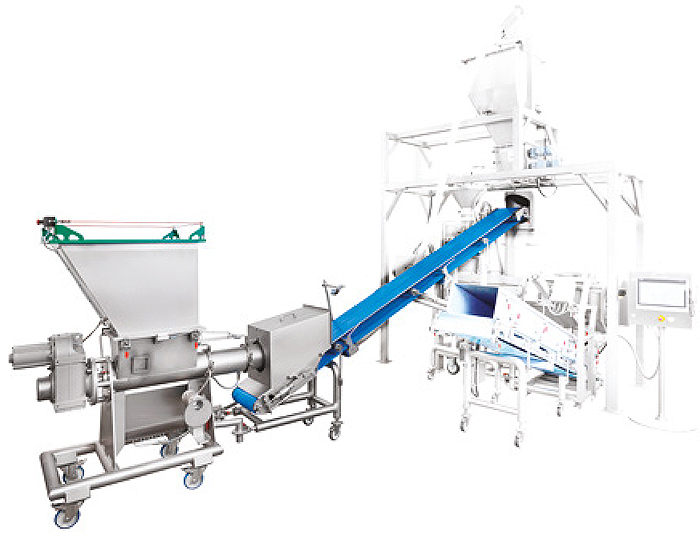DIOSNA - Work economically - Act responsibly
Written by: Dr. Torsten H. Zense, Diosna Dierks & Söhne GmbH
 Sustainability in the bakery business can be characterised in many different ways but more typically it manifests itself as responsible purchasing of ingredients and packaging materials at any point in the supply chain, taking into consideration origin of raw materials and their relation to farming methods. In the bakery establishment itself, the essential area of importance is that of optimisation of the baking processes themselves with respect to energy saving and recovery.
Sustainability in the bakery business can be characterised in many different ways but more typically it manifests itself as responsible purchasing of ingredients and packaging materials at any point in the supply chain, taking into consideration origin of raw materials and their relation to farming methods. In the bakery establishment itself, the essential area of importance is that of optimisation of the baking processes themselves with respect to energy saving and recovery.
Depending on the type of baked product and machinery used for production, there are also product related flows and responsibilities which need to be taken into account such as the re-use of scrap dough or bread off-cuts or the reducing of ingredient residues. Where no options to recirculate such products, which are, of course, very valuable materials, it is unfortunate that they should be regarded as "waste", an incredible thought in light of the current push to achieve a fully sustainable production paradigm.
Traditionally, solutions have been researched and developed to re-circulate high quality waste materials back into process and product. In this short article, therefore, we would like to focus on both well-known and on some new approaches to resolving such waste product problems.
Bread
Unused or unsold bread slices and even whole loaves can be cut up, blended and re-used easily or alternatively mixed with water in so-called bread mixers and, in some circumstances, residues can be turned into final bread dough as long as national laws governing the highest levels of hygiene, traceability rules and standards are observed.
As the storability of bread slurries such as these is limited, several possible solutions have been researched with relevant studies aiming to investigate prolonging potential shelf life. An example of such a study, demonstrated that the simple solution of lowering the storage temperature could extend the product's shelf-live to some extent but that it was still limited.
Recently, a new approach has been gaining traction: it could be possible to learn lessons from the vegetable processing industry which has developed an idea which involves introducing fermentation to the bread slurry. Such a process now being developed, has already been successfully applied to rye bread since the eighties of the last century. However, in order to apply this solution for wheat bread, the parameters and starter cultures used had to be redeveloped.
By the so-called 'wheat bread fermentation'1 process, unsold and unsaleable bread can be completely re-fermented by cutting the bread in special machines and adding a wheat fermentation culture. Thus, the old bread is transformed completely into a high-flavour sourdough, which now then be stored for up to one week, without cooling. Traceability is assured by observing production batches used for this process and by virtue of the fact that it is started from scratch each time.
But, you may be thinking that if sourdough is added to wheat bread recipes, will our discerning customers accept this, many of whom are puritan sourdough consumers? The answer is: A small percentage of fermented bread, added to the bread dough, will not change the taste intensely, but indeed optimise flour hydration, enrich final bread flavour, prolong its freshness and well as its frozen storage stability.
Dough
Another important area of waste product is the increasing problem of large quantities of scrap dough in modern-day production, especially in bakeries utilising sheeting lines. For products which are cut out of dough sheets, such as pizza bases, it is obvious, that a high amount of left -over dough will accumulate. As is common practice, this residual dough is normally transferred to mixers or hoppers using return belts, however, with it still being in its "active", non-baked state and, therefore, still containing live yeast, the quality of the main dough is affected perceptibly. As an alternative, the "waste" product can now be processed in bread mixers or special tanks with fast-rotating tools in order to produce a dough slurry. The water quantity needed to make the dough slurry manageable varies according to both dough consistency and the equipment used.
In order to take advantage of the cooling benefits of the slurry, previously mentioned, the use of pre-cooled water will render increased efficiency of the process raised since the final temperature of dough slurry determines the duration of possible storage. Cooled down and stored in cooling tanks, storage is possible for up to 24 hours.
This may pose the question: is this period sufficient when a longer storage capability would be much more useful? In a typical bakery production set up, production breaks are commonplace which would render some waste dough as being unusable for recycling. However, if leftover dough is stored during bridging such a production break, it can be integrated immediately with restart of production and the same recipe can be used. And, of course, it is not only economically beneficial, but also becomes part of the sustainability requirements.
Inspired by the bread fermentation process described above, the scrap dough may be mixed with mother sourdough and fermented for a short period resulting in a potential storage of up to three days, depending on its pH value and temperature selected.
How does this affect Danish/puff pastry, containing margarine or butter? The concept of using a pre-dough fermentation has also been developed for such products2. The application described enables the baker to re-use 20% – 25% of total dough weight from fermented leftover dough.
Incredible as it may seem, fermented dough in products such as croissants is now perfectly possible and is being adopted by an increasing number of bakeries using an approximate proportion 7% mild sourdough to enrich noticeably, the butter flavour of croissants.
Conclusions
Methods of enabling the re-use of process flows like leftover dough or even unsaleable bread, will not only be an economic solution to improve sustainability of the baking process, but also contribute to improved quality of baked products.

References:
1. European patent No. 3086650
2. European patent No. 3223618
2903